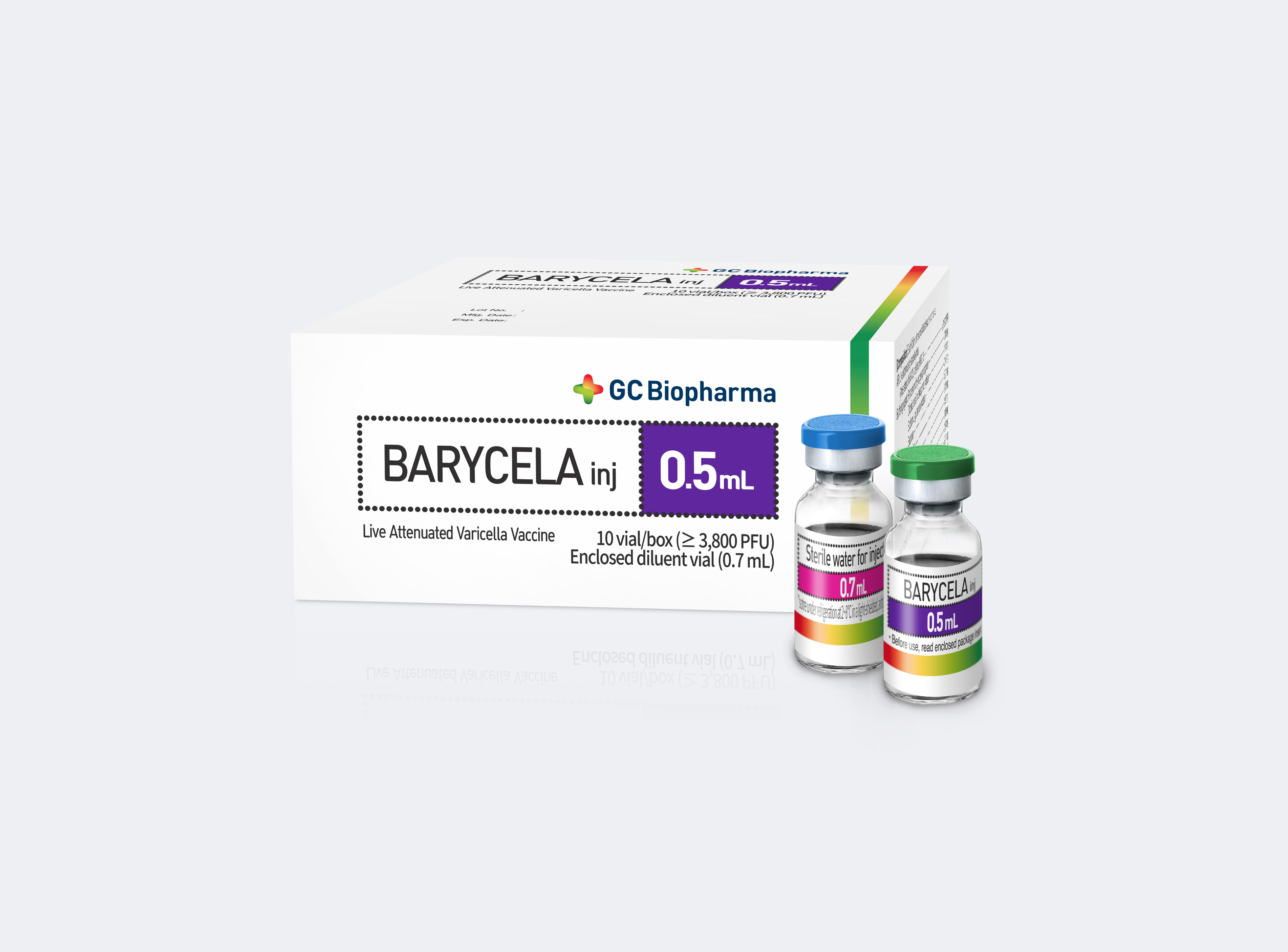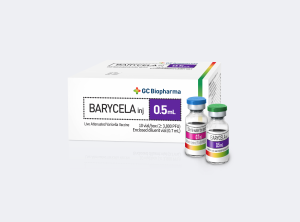The vaccine is prepared from live attenuated Edmonston–Zagreb strain measles virus, L-Zagreb (L-Z) strain mumps virus, and Wistar RA 27/3 strain rubella virus. Measles and rubella viruses are propagated on human diploid cells (HDC), while the mumps virus is propagated on chick embryo fibroblasts from SPF eggs. The vaccine is freeze-dried with accompanying diluent. The product is in the form of a freeze-dried white to light yellow pellet. The vaccine meets WHO standards when tested by methods described in WHO TRS 840 (1994).
POTENCY
Each single dose, after reconstitution with 0.5 ml volume, contains at least 1000 CCID50 of live measles virus, 5000 CCID50 of live mumps virus, and 1000 CCID50 of live rubella virus. Freeze-dried vaccine stored at 37°C for 7 days does not show reduced potency (virus titer reduction less than 1.0 log10).
INDICATIONS
Active immunization against measles, mumps and rubella in children from 12 months to 10 years of age. The second MMR dose may be administered any time before 6 years of age (school entry 4–6 years). In children over 10 years, adolescents and adults, booster doses are recommended for measles and rubella. Booster immunization may seroconvert non-responders to the first dose or increase antibody titers in previously vaccinated persons whose titers have waned. The Advisory Committee on Immunization Practices (ACIP) recommends the first dose of MMR at 12–15 months of age and the second dose at 4–6 years of age. Immunization for adolescent and adult women not pregnant is indicated if clear warnings apply (see CONTRAINDICATIONS). The vaccine may be administered concomitantly with DTP, DT, TT, Td, BCG, Polio (OPV, IPV), Haemophilus influenzae type b, Hepatitis B, Yellow Fever vaccines, and Vitamin A supplementation.
DIRECTIONS FOR USE AND DOSAGE
The vaccine must be reconstituted with the supplied diluent (sterile water for injection) using a sterile syringe and needle. Gently shake to dissolve the freeze-dried pellet. The vaccine must be administered immediately after reconstitution. A single 0.5 ml dose is injected subcutaneously into the anterolateral thigh for young children and into the upper arm for older children. If not used immediately, the reconstituted vaccine must be stored protected from light at 2°C–8°C for no longer than 6 hours. Opened vaccine vials (within 6 hours of reconstitution) must be discarded. The Vaccine Vial Monitor (VVM – see details) must be removed immediately upon reconstitution. The supplied diluent is specially formulated for this vaccine. Only the accompanying diluent must be used to reconstitute the vaccine. Do not use diluents from other vaccines or MMR vaccines from other manufacturers. Incorrect diluent use may damage the vaccine and/or cause serious adverse reactions in recipients. The diluent must not be frozen but kept cool.
CAUTION: CONTRAINDICATIONS MUST BE OBSERVED
Before administration, both the diluent and reconstituted vaccine must be visually inspected for foreign matter or physical changes. If observed, discard immediately.
ADVERSE REACTIONS
The type and frequency of rare adverse reactions are not significantly different from those reported separately for measles, mumps, and rubella vaccines.
Within 24 hours post-vaccination, measles vaccine may cause mild pain and tenderness at the injection site. Most cases resolve spontaneously within 2–3 days without medical intervention. Mild fever may occur 7–12 days after vaccination and last 1–2 days, affecting 5–15% of recipients. Rash occurs in about 2%, typically 7–10 days post-vaccination, lasting 2 days. Mild reactions rarely occur after the second dose and usually only in those not protected by the first dose. Encephalitis has been reported at about 1 per million doses, but causality remains unproven.
Mumps component may cause parotitis and mild fever. Febrile seizures and orchitis may occur. Rare moderate fever and very rare aseptic meningitis have been reported. Vaccine-related meningitis usually appears within 1 week, resolves without sequelae, but delayed onset (15–35 days) may limit detection by passive surveillance. Rubella component may cause joint pain (25%) and arthritis (10%) in adolescent and adult women, lasting several days to 2 weeks. Rare in children and men (0–3%). Symptoms typically begin 1–3 weeks post-vaccination and last 1 day to 2 weeks. Other mild reactions include low-grade fever, rash, lymphadenopathy, myalgia, and malaise. Thrombocytopenia is very rare (<1/30,000). Anaphylaxis is rare. Occasional isolated CNS-related reactions have been observed. More severe adverse events have been reported but are not directly attributable to vaccination.
REPORT TO PHYSICIAN ANY UNDESIRED ADVERSE REACTIONS WHEN USING THIS PRODUCT
DRUG INTERACTIONS
Due to risk of inactivation, MMR vaccine should not be given within 6 weeks, and preferably within 3 months, of administration of immunoglobulins or blood products containing immunoglobulins (blood or plasma). For the same reason, immunoglobulins must not be given within 2 weeks after vaccination. Tuberculin-positive individuals may convert to negative after vaccination.
CONTRAINDICATIONS AND WARNINGS
Individuals on corticosteroids, other immunosuppressive drugs, or undergoing radiotherapy may have suboptimal immune responses. Do not administer vaccine to individuals with fever, pregnancy, acute infectious disease, leukemia, severe anemia, or other severe blood disorders, renal dysfunction, decompensated cardiac disease, receiving gammaglobulin or blood transfusion, or those allergic to vaccine components. The vaccine may contain traces of neomycin. Absolutely contraindicated in individuals with hypersensitivity or allergy to neomycin or eggs (egg protein allergy). Not contraindicated in cases of mild fever, mild respiratory infections, diarrhea, or other mild illnesses. Malnourished children must especially be vaccinated.
Do not administer MMR vaccine to pregnant women due to potential teratogenic risk, although unproven. Accidental administration during pregnancy is not an indication for termination. Women planning pregnancy must wait one month after MR vaccination. No serious adverse effects have been reported in women accidentally vaccinated during early pregnancy with rubella-containing vaccines.
IMMUNOCOMPROMISED INDIVIDUALS:
MMR vaccine may be given to HIV-infected or suspected HIV-infected children. Contraindicated in individuals with severe immunodeficiency due to congenital disease, advanced HIV infection, leukemia or lymphoma, malignancy, or receiving high-dose steroids, alkylating agents, antimetabolites, or radiotherapy.
STORAGE
BOTH FREEZE-DRIED AND RECONSTITUTED VACCINES MUST BE PROTECTED FROM LIGHT.
Store vaccine at 2°C–8°C in the dark.
Diluent must be kept cool but not frozen.
SHELF LIFE
24 months from the last satisfactory potency test result, provided storage at 2–8°C in the dark.
PRESENTATION
Single-dose vial with 0.5 ml diluent.
VACCINE VIAL MONITOR (VVM)
VVM is part of the label on the MMR live attenuated vaccine supplied by Serum Institute of India Pvt. Ltd. A colored dot on the label represents the VVM. It is a heat- and time-sensitive area indicating cumulative heat exposure of the vial. It shows when the vial must be discarded due to loss of quality.
Reading the VVM is simple. Observe the inner square: its color gradually darkens. If the inner square is lighter than the outer circle, the vaccine may be used. If the inner square matches or is darker than the outer circle, the vial must be discarded.
CONSULT YOUR PHYSICIAN FOR FURTHER INFORMATION
IMPORTANT WARNING
Ensure vaccine is administered subcutaneously. Anaphylactic shock may occur; therefore, adrenaline 1:1000 must be readily available for subcutaneous or intramuscular injection. In severe cases, administer adrenaline 0.1–0.5 mg (0.1–0.5 ml of 1:1000 solution) intramuscularly or subcutaneously. Single dose must not exceed 1 mg (1 ml). For infants and small children, recommended adrenaline dose is 0.01 mg/kg (0.01 ml/kg of 1:1000 solution). Single dose must not exceed 0.5 mg (0.5 ml). Immediate administration of adrenaline can effectively prevent severe reactions.
The primary principle in treating severe hypersensitivity reactions is adrenaline administration, which can be life-saving. Adrenaline should be given at the first suspicion of anaphylaxis. As with all vaccines, recipients must be observed for at least 30 minutes post-vaccination. Hydrocortisone and antihistamines, as well as supportive measures such as oxygen, must be available.
MANUFACTURER: SERUM INSTITUTE OF INDIA PVT. LTD.
Address: 212/2, Hadapsar, Pune 411028, India









